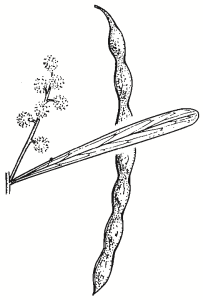Family:
Fabaceae
Acacia hakeoides
Hakea Wattle
Other Names: Western Black Wattle, Hakea-leaved Wattle

Name Origin:
hakeoides – refers to likeness of ‘leaves’ to those of some Hakeas.
Regional Subspecies:
Similar Species:
Distinguish from Drooping Wattle (A. difformis) by ‘leaf’. Drooping Wattle has lighter green ‘leaf’ and flattened ‘leaf’ stem.
Occurrence:
Regional:
Common in areas west of the Olympic Highway.
Australia:
Qld, NSW, Vic, SA, WA.
Habitat:
Woodland and mallee, on sand.
Habit:
Erect or spreading hairless shrub, mostly 1-6 m high. Smooth or finely fissured grey-brown bark and angled or flattened branchlets
Site Preference:
Medium to well-drained light to heavy soils. Partial or full sun. Very hardy. Withstands frosts and extended dry periods.
Characteristics:
Moderate growth rate. Lifespan up to several decades. Not known to be eaten by livestock.
Flowering:
Golden-yellow, usually Jul-Nov.
Seed Collection:
Early Dec to late Jan.
Propagation:
From scarified seed (± 12 viable seeds per gram), or cuttings.
Regeneration:
Frequently forms dense thickets. Establishes readily when direct seeded.
VALUES:
Shade & Shelter:
Excellent low-level cover in windbreaks.
Land Protection:
Useful for controlling soil erosion due to soil-binding fibrous roots. Legume — improves soil fertility by ‘fixing’ nitrogen.
Wildlife:
Good habitat. Flowers are a food source for native insects and birds.
Fuel:
Good.
Ornamental:
Excellent ornamental due to quick growth, prolific flowers and dark foliage.
